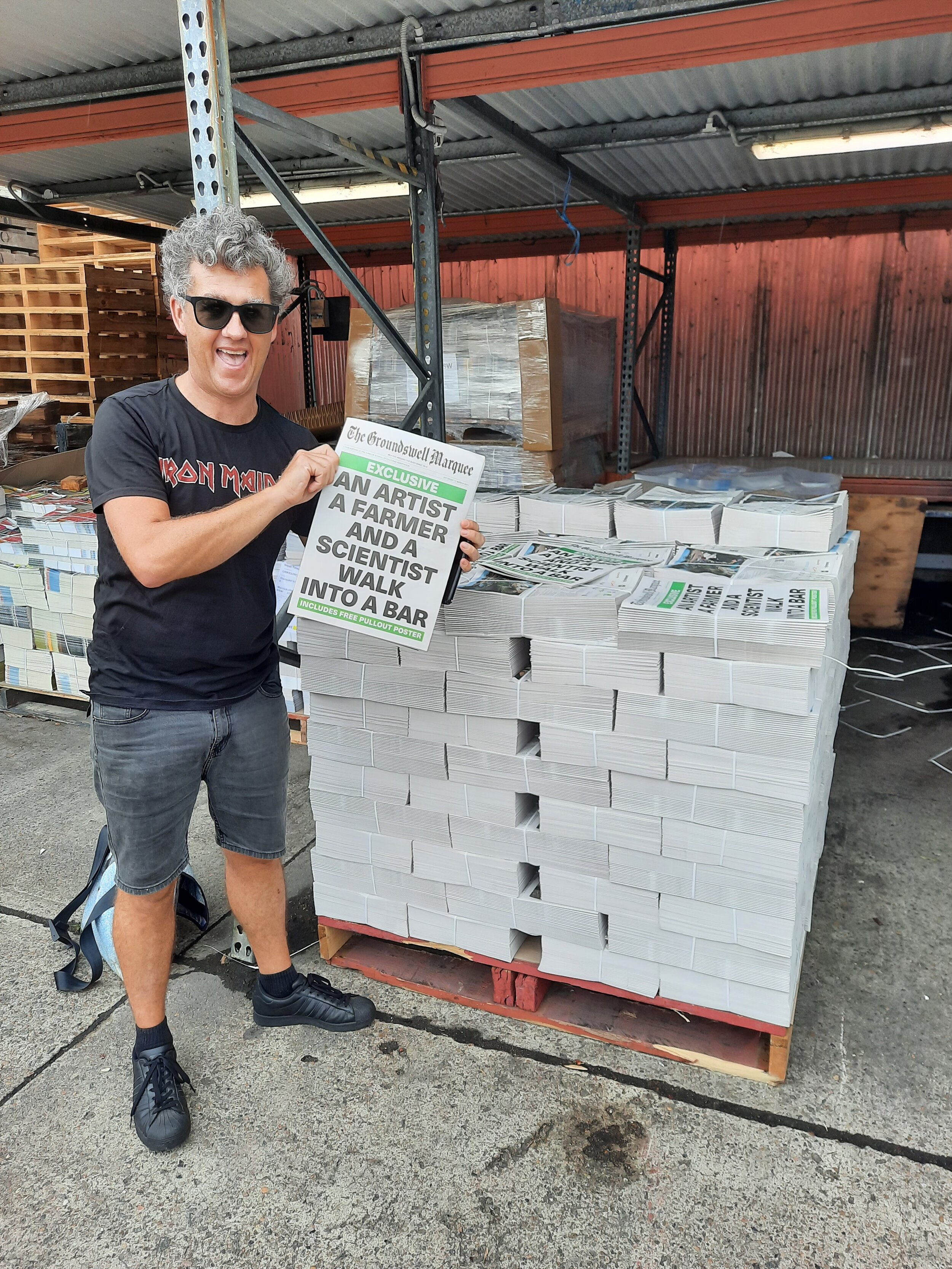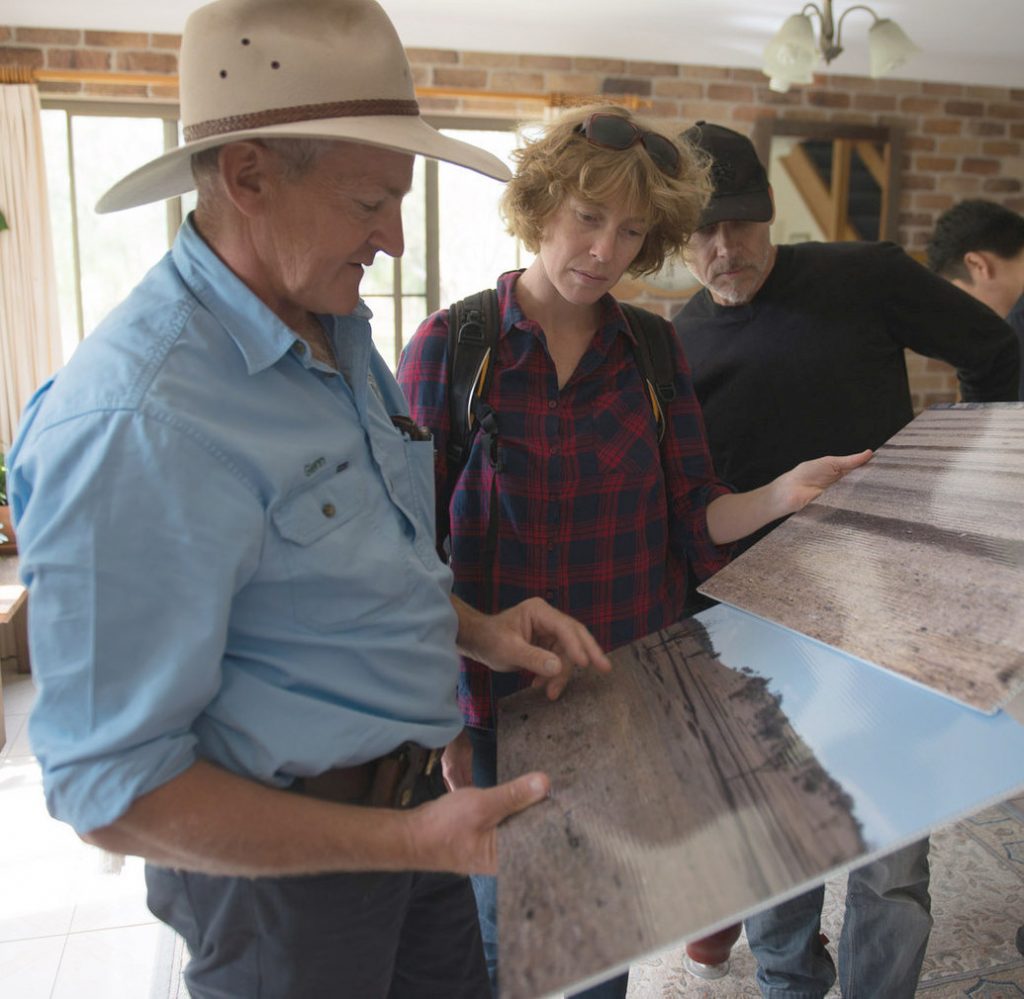It’s 56 pages long, raw and wriggling, and it has a free pull-out poster. We have finally published the newspaper that tells the story of ‘An artist, a farmer and a scientist walk into a bar’, and we’d love to share it with you.
An Artist, a Farmer, and a Scientist - intro video!
“Keep Calm, and wear odd socks”
Reflections on cultural adaptation in practice
By Alex Wisser
Kandos School of Cultural Adaptation was recently invited to speak at “What do we teach, how do we learn”, a Sydney Biennale event at Artspace querying the relationship between art and teaching. It fell to me to string together some semi-cogent sentences in representation of our group. Preparing for the talk proved itself an exercise in arbitrary narrative synthesis because our group is very intentionally structured to maintain the multiplicity of its members and does not easily reduce to a unified common voice or position. So, attempting to “speak for the group” is itself problematic.
My solution was to begin with a disclaimer not unlike the one above and then to concentrate on exactly the “soft structure” of our group as a subject matter, throwing in some reflection on my own ‘pedagogical’ experience as a member of the Kandos School of Adaptation’s student body (seeing as this was the subject of the talk – and also a favorite subject for reflection of mine). The text below is adapted from the original talk.
The Kandos School of Cultural Adaptation began life as a fiction that grew up to become a real thing (not unlike an artwork). Despite its newfound reality, the structure of KSCA retains the unreal quality of its fictional beginnings and having none of the material trappings we would normally associate with an institution of learning, the school itself became its name – a moniker that when placed onto a project would magically render the institutional resources of KSCA at the disposal of that project. Through this fluid structure, the individual members of the group are able to maintain our own initiative while still having recourse to the collective support and engagement of the group.
It occurs to me that this structure might be called superficial. It organizes from the surface as more of an exoskeleton than an endoskeleton. It possesses little essential identity but becomes what it becomes through the activity we pursue in its name. The signifier remains constant as the signified shifts beneath it.
This does not mean that it has no structure. The four words Kandos School of Cultural Adaptation regulate and organize whatever content they are given. Whatever activity is placed beneath them becomes subject to the aperture that the name imposes. Any activity so designated becomes a learning activity and the subject of that learning, its discipline if you will, is the phenomena of cultural adaptation. Instead of imposing these elements upon a project as their a priori criteria for inclusion, these elements are discovered, emphasized and brought into focus within the activity of any project adopted by the group.
The term ‘cultural adaptation’ refers to the idea that if art can be seen as an activity that functions specifically to adapt culture to the changing conditions of social reality, then any activity that changes culture can be seen as art. Art, defined as cultural adaptation, leaves the museum and gallery cul de sac and opens onto the entire field of cultural activity. It can take place anywhere. It happens in the office or the block of flats, at the bus stop or the parking garage, it happens in a paddock or at a football game. It happens at any point within our society at which conventional practice is challenged, shifted or broken in the pursuit of new cultural modes often catalysed by a changing social reality. For an artist, the prospect of applying the conceptual and communicative strategies of my art practice to a point of cultural change outside of the artworld is very exciting.
Glenn Morris shows us historic images of Billabong, the property now under his regenerative management
To put this into relief, our current project “An Artist, A Farmer and a Scientist walk into a bar…” centres around a community of farmers who, on their own initiative, compelled by economic necessity as much as ethical or idealistic concern, are turning away from the high input conventions of chemical dependent industrial farming toward methods that regenerate soil fertility, cultivate biomass and encourage soil water retention. In pursuing these changes in their practices, they place themselves in contrast to the forces and interests of the existing industrial farming economy as well as the conventional farming community to which they had previously belonged. As a result, they face a resistance that seems to encompass the existing social world.
Tim Wright's impressively healthy grasslands produced through holistic management practices on Lana NSW
What I believe we are witnessing and potentially participating in, is a point of cultural change. Material social and economic pressures are building within a certain regime of practice and this is driving a change in behavior amongst those who directly participate within it. This change meets its necessary resistance in the form of the status quo: the culture as it exists closes ranks against the perceived threat of change, presenting a united front that stretches from the company board room to the local pub, from the evening news to the queue at the newsagents.
So, you might ask, how does an artist 'participate' at this point of cultural change? That is something we are still learning. And that perhaps is the most appropriate answer. It occurs to me that all of art is but a specific form of learning - an observation of the world made through an attempt to reflect, present or represent it. It is for this reason that artists loose interest in a work as soon as they know what they are doing - there is no learning to be gained from it.
To use my own circumstances as an example, agricultural practice is not only a subject of which I am profoundly ignorant, but also a subject in which I had no previous interest. I am not drawn to it as a preoccupation but through this project, I find myself (along with all of my preoccupations) nonetheless immersed within it. I am engaging with an entire realm of experience that I would have never chosen for myself, because I had no intellectual connection to it. For me, this circumstance or the circumstantial nature of KSCA predicates a kind of learning that is difficult or even impossible in more traditional educational contexts. Instead of working within the field or discipline of my competence, I (along with all my competencies) am dropped into a world of which I am manifestly ignorant. And what better place from which to acquire an education than ignorance.
The learning that occurs at this point of contact between my “self” and the world for which I am not prepared is incredibly generative. The world I bring with me, in its efforts to comprehend the world I am entering, begins to generate connections that were inconceivable before the confrontation I am attempting to describe. In the process, the resistance of the world I thus struggle to understand, challenges and decomposes much of the understanding I throw at it, forcing it (my understanding) to regenerate in forms that have been altered by the process. If left to my own devices, I would only have my own devices to work with, and little enters from the outside.
Rick Hutton shows the KSCA crew around The Living Classroom at Bingara
Which brings me back to cultural adaptation because it is an idea that I now carry with me everywhere. It functions less a matrix through which I can render the world comprehensible, and more as a question that I can ask at those points that I don’t understand what is going on. The question, if I were to formulate it out loud, would sound something like “How does this thing participate in cultural change?” This question is not something that I have to answer, nor really should I. The answer will come with the change that the question interrogates – it might take 10 years for the answer to emerge. In the meantime, I have a fulcrum for lifting that change into a perspective from which I can observe it, learn from it, and hopefully participate in the adaptation we make as a society to that change.
In the context of the AFS project, this method has already produced some striking results. Through conversation with our partners, we were able to identify a point at which we as artists might begin to contribute to their work. These farmers, whom I believe to be at the leverage point of a broader cultural change, find themselves isolated on three levels: from the conventional farmer community who view their activity with suspicion, from other farmers pursuing similar methods (for no other reason than that they are isolated geographically) and from the scientific community that will ultimately sanction or deny the value of the work they are doing. This isolation is particularly frustrating as it also excludes them from participating in the broader national conversations around environmental and land care concerns.
From this recognition we have devised a number of strategies that target these constraints, creating connection and allowing blocked energy to flow. “An Artist, a Farmer and a Scientist walk into a bar…” develops these strategies through eight engagement projects that will stir dialogue, establish lines of communication, and hopefully resonate the results to targeted audiences.
Its all about the grass
Beyond the specific, concrete applications, the KSCA method has another, unexpected outcome. By looking at our subject as a point of cultural change, I no longer perceive the vast, static and immovable mass of the existent world in its Goliath opposition to the infinitesimal David-like band of farmers advocating for change. What I look at now is a site of culture change: far from being an isolated movement in a static landscape of enduring truths and realities, it is a particular point of change within a culture that exists in a constant state of movement. What it will change into is a matter of how we adapt to it. If left to its current tendencies, the culture will likely degenerate into a more and more destructive modes of behavior. But likewise, it opens the possibility that we can adapt this cultural change to better fit our changing material and social circumstance. No longer is the struggle conceived as that of moving a mountain – the mountain is already in motion; the challenge is how we direct its movement.




















